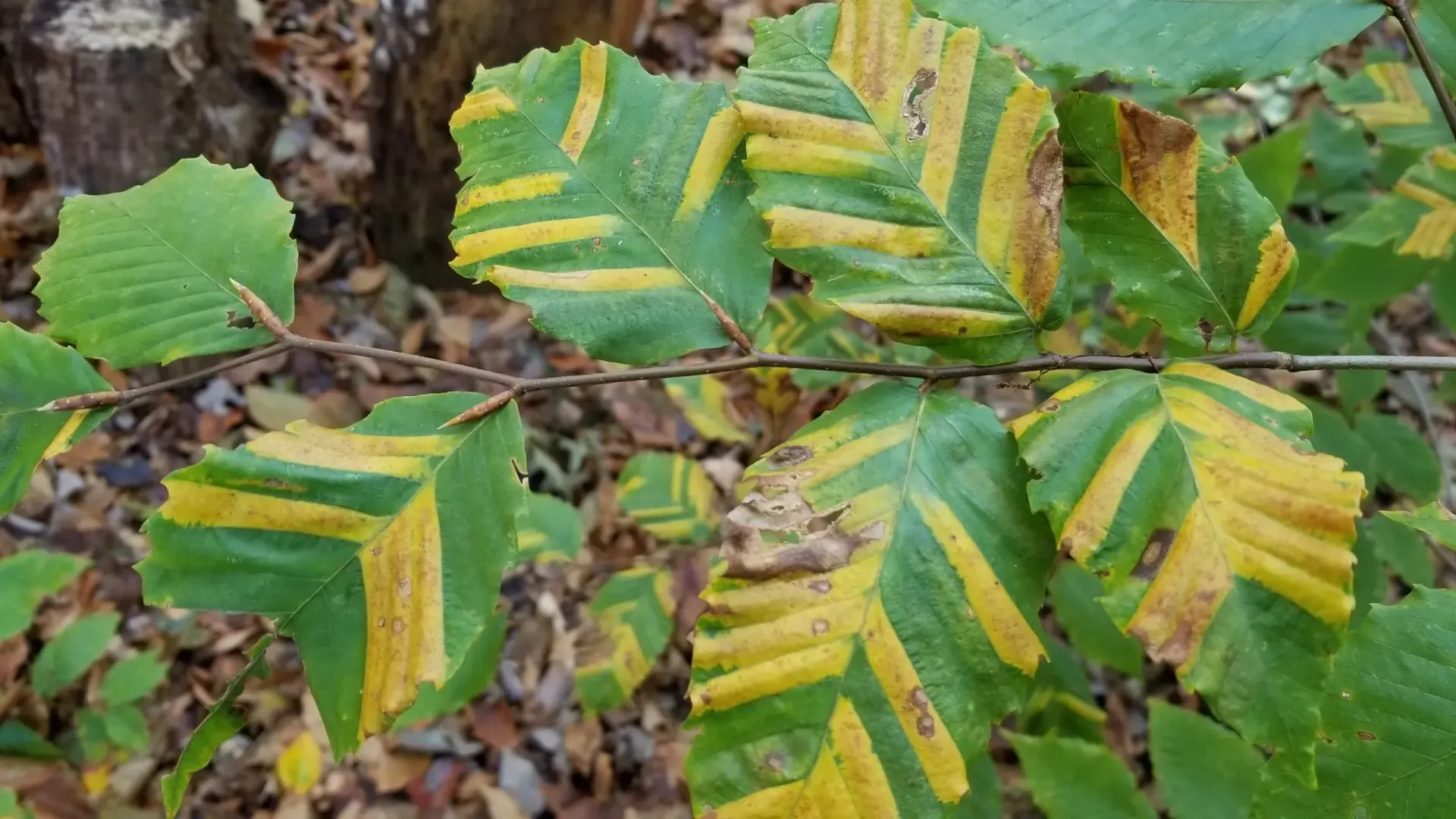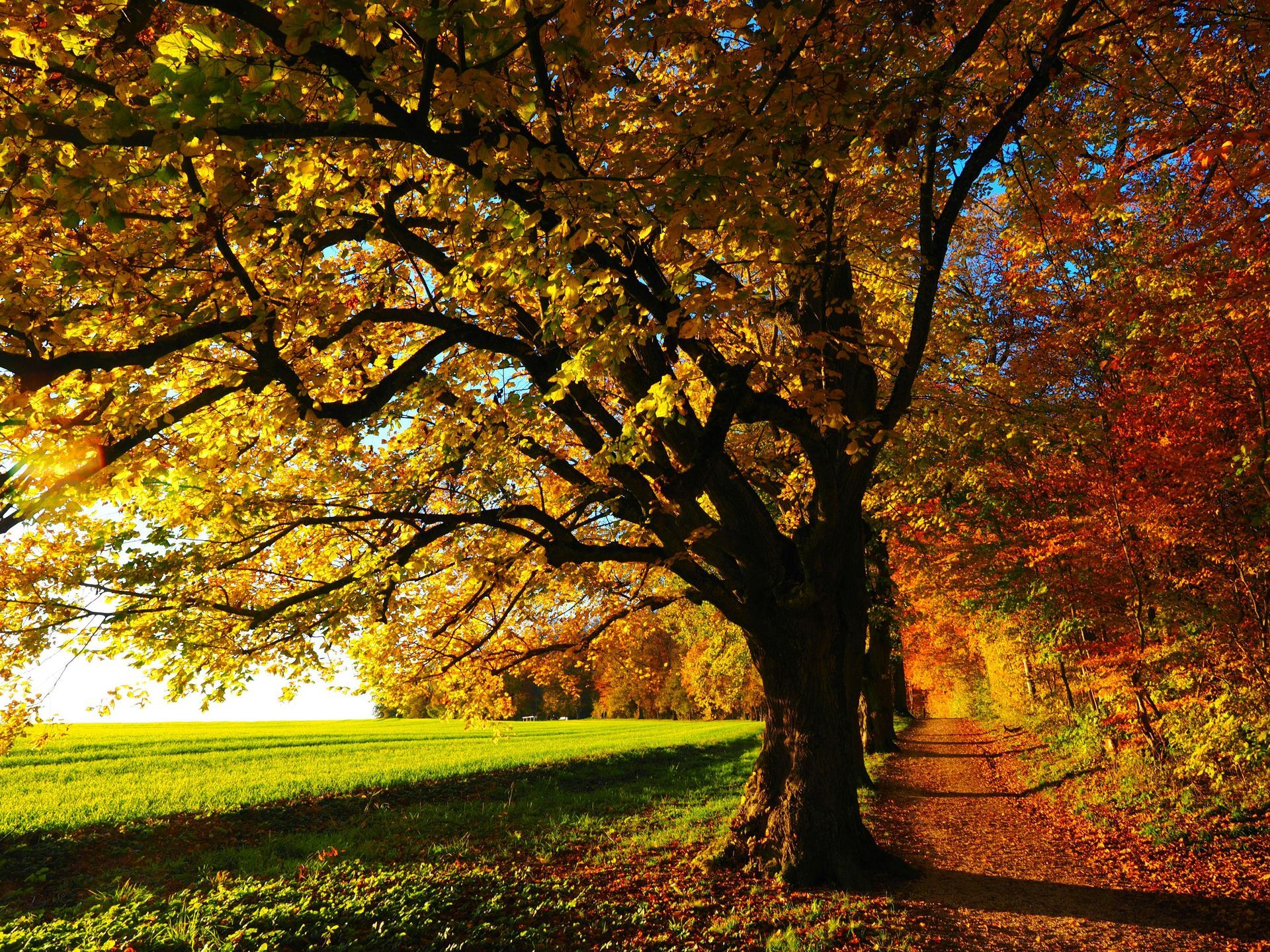
Beech trees have long been a beloved part of New Jersey’s natural landscape. Whether lining suburban streets or dotting wooded parks, these iconic trees offer shade, beauty, and biodiversity. But in recent years, a serious threat has emerged— Beech Leaf Disease (BLD) . First reported in Ohio in 2012, BLD has rapidly spread, and New Jersey is now among the affected states. What Is Beech Leaf Disease? Beech Leaf Disease is a condition that impacts American, European, and Oriental beech trees. The disease is believed to be associated with a nematode— Litylenchus crenatae mccannii —which invades leaf tissue and leads to a slow decline in tree health. Although research is ongoing, the damage BLD causes is evident. What Are the Symptoms? If you suspect a beech tree on your property may be infected, here’s what to look for: Dark bands between leaf veins (especially on the underside) Curling or leathery texture of leaves Premature leaf drop Sparse canopies as the disease progresses Bud failure and dieback over time Unfortunately, once infected, trees may begin to decline within just a few seasons. Why Is BLD a Concern in New Jersey? New Jersey is home to extensive beech forests and countless urban and suburban beech trees. With BLD now present in multiple NJ counties, it poses a serious threat not just to individual trees, but also to larger ecosystems and property values. If left unchecked, BLD can lead to widespread tree loss, increased removal costs, and disrupted habitats for native wildlife. What Can You Do? While there is no cure yet for Beech Leaf Disease, early detection and monitoring are key . If you suspect your tree is infected: Contact a certified arborist or your local Cooperative Extension office. Avoid unnecessary pruning to reduce stress. Clean equipment and footwear when moving between properties to prevent the spread. Stay informed about local quarantines and best practices. In addition, maintaining the overall health of your trees can help them resist stress and secondary pests, including scale insects , which are increasingly common in stressed landscapes. Bonus Resource: Managing Scale Insects Diseases like BLD often leave trees vulnerable to secondary pests , including scale insects. These tiny, sap-sucking insects can further weaken trees, making proactive management essential. We’re including a helpful, downloadable resource to guide you or your arborist in identifying and managing scale insect infestations: 👉 Download the Scale Insect Management Guide (PDF) Learn how to identify different types of scale, understand their life cycles, and apply proven treatments for long-term tree health. Stay Vigilant, New Jersey Beech Leaf Disease is a growing threat, but with awareness and the right tools, we can help slow its spread and protect the trees that make our neighborhoods and forests beautiful.

If you want healthy trees, you have to start at the root—literally. Soil is more than just dirt. It’s a living, breathing ecosystem that serves as the foundation for everything growing above it. At Frontier Tree Co , our Soil Management Program is designed to restore and protect that foundation, giving your landscape the underground support it needs to thrive for years to come. Why Soil Health Matters for Trees and Shrubs Soil isn’t just where roots grow—it’s where plants find nutrients, water, oxygen, and the microbial support needed to resist pests and disease. When soil becomes unhealthy, everything above it suffers. You might not see what’s happening beneath the surface, but your trees can feel it. Signs Your Soil May Be Stressed: Struggling or stunted plant growth Yellowing or curling leaves Early leaf drop or thin canopies Water pooling or draining too quickly after rain Fungi, mildew, or moss overgrowth at the base of plants These issues aren’t always caused by the plant—they’re often rooted in the soil itself. Common Soil Problems We See in NJ Landscapes Here in New Jersey, especially in urban and suburban neighborhoods, our trees and shrubs face many common soil-related challenges: 1. Compacted Soil Heavy foot traffic, machinery, or poor landscaping practices can compress the soil. This reduces airflow and makes it hard for roots to expand and absorb water and nutrients. 2. Poor Drainage or Excess Moisture Some soils retain water too long, creating soggy root zones. Others drain too quickly, leaving roots dry. Either scenario stresses the plant. 3. Nutrient Imbalances Too much or too little nitrogen, phosphorus, or potassium can lead to weak, discolored foliage and poor growth. Even “well-fed” plants can struggle if the nutrients aren't balanced properly. 4. Low Microbial Activity Healthy soil is alive with beneficial bacteria, fungi, and microorganisms that help break down organic material and fight off harmful pathogens. Overuse of chemicals can disrupt this natural balance. How Frontier’s Soil Management Program Helps At Frontier Tree Co, we believe in caring for your yard from the ground up. Our Soil Management Program uses a combination of organic treatments , aeration , and custom soil amendments to breathe life back into your soil. Our Approach: Soil Testing & Analysis We start with a comprehensive soil test to understand exactly what your landscape needs—and what it doesn’t. Organic Soil Conditioners We apply natural products that add beneficial organisms, improve structure, and support sustainable growth. Aeration By loosening compacted soil, we allow roots to access oxygen, water, and nutrients more effectively. Customized Nutrient Plans We don’t apply one-size-fits-all solutions. Your soil gets the exact blend of nutrients it needs—nothing more, nothing less. Ongoing Monitoring Healthy soil takes time. We revisit your landscape throughout the year to ensure lasting results and make adjustments as needed. The Results: Why Healthy Soil Pays Off When your soil is healthy, your entire landscape transforms. ✅ Stronger Root Systems – Roots grow deeper, anchor better, and resist drought and storms more effectively. ✅ Improved Tree and Shrub Growth – Lusher leaves, fuller canopies, and longer-lasting blooms. ✅ Fewer Pest and Disease Issues – Healthy plants are more resilient and less attractive to harmful insects and fungi. ✅ Greater Longevity – Trees and shrubs with strong foundations can live decades longer. Investing in your soil is one of the smartest, most cost-effective ways to improve the health and beauty of your outdoor space. Ready to Dig Into Healthier Soil? Your trees, shrubs, and garden plants all rely on one thing: the soil beneath them. With Frontier Tree Co’s Soil Management Program , you’re not just improving the look of your landscape—you’re helping it thrive naturally and sustainably for years to come. 📞 Call us today or schedule a soil assessment online. Let’s bring your soil—and your trees—back to life.

At Frontier Tree Co , we know that tree care isn't just about improving curb appeal—it's about creating a healthier environment for your family, your pets, and the planet. That’s why our Plant Health Care (PHC) program is built on organic, eco-conscious practices designed to nourish your landscape naturally and safely. You don’t have to choose between beautiful trees and a safe yard—you can have both. Why “Organic” Tree Care Matters More Than Ever Conventional tree treatments often rely on synthetic chemicals that can leave behind harmful residues. These chemicals may work fast, but they can have unintended consequences—affecting beneficial insects, seeping into soil and water systems, and posing risks to children and animals who play outdoors. Our organic PHC approach focuses on long-term plant vitality by working with nature, not against it. We Treat Your Yard Like Our Own We understand how important it is for families to feel safe and confident in their outdoor space. That’s why every product and method we use is selected for its safety, sustainability, and effectiveness. Safe for Families, Pets & Pollinators Our clients love that our services are as friendly to people and animals as they are to trees and shrubs. Here’s what organic and family-safe care looks like at Frontier Tree Co: Child-Safe Treatments: We avoid harsh synthetic pesticides, fungicides, and herbicides. Our materials are chosen to minimize exposure risks for curious kids and reduce airborne drift. Pet-Friendly Practices: We use ingredients that won’t harm dogs, cats, or other outdoor companions. There’s no need to keep pets off the lawn after treatment. Bee & Pollinator Protection: Unlike many traditional treatments that unintentionally kill beneficial insects, our approach protects bees, butterflies, and ladybugs , which play essential roles in your garden’s health. Earth-Friendly Solutions: Our fertilizers and soil amendments are organic-based and biodegradable, helping reduce runoff and support healthy soil life. Frontier’s PHC program helps you protect what matters most—your loved ones and your landscape. What’s Inside Our Organic PHC Program? Our program is more than just a pesticide alternative. It’s a holistic system that supports plant health from root to canopy. Components of Our Organic Program: Soil Enrichment : We improve soil health using natural composts, organic fertilizers, and microbial inoculants to create a thriving underground ecosystem. Organic Pest Management : We use plant-based oils, biological controls, and beneficial insect support to manage pests without damaging the surrounding environment. Tree & Shrub Nutrition : Our customized fertilization plans use slow-release organic blends that promote steady, healthy growth. Disease Resistance Building : We strengthen your plants' natural defenses so they can resist disease, weather stress, and pests. Benefits of Going Organic with Frontier Switching to organic tree care provides more than just peace of mind—it delivers real, visible results for your yard. The Benefits: Lush, healthy trees and shrubs Fewer pest and disease outbreaks Safer outdoor space for your children and pets Improved soil life and pollinator activity Sustainable practices that reduce environmental harm You’ll see the difference—and feel good knowing you’re caring for your yard in a way that protects your family and the Earth. Choose Healthier, Safer Tree Care—Choose Frontier If you’ve ever worried about what’s being sprayed on your trees—or what your kids or pets are stepping in—it’s time to make the switch. With Frontier Tree Co’s organic Plant Health Care , you’re getting more than just expert service. You’re getting peace of mind. 📞 Call us today or schedule a free consultation online. Let’s grow a healthier future—one yard at a time.

At Frontier Tree Co , we’ve proudly served New Jersey communities for more than 40 years. Known for our commitment to expert, ethical tree care, we're excited to reintroduce our Plant Health Care (PHC) Services — a proactive, organic approach to nurturing healthier trees, stronger shrubs, and more vibrant landscapes. In today's environment, trees need more than just trimming—they need consistent care. And that’s where PHC comes in. What Is Plant Health Care (PHC)? Plant Health Care is an ecosystem-based strategy for maintaining the health of your trees and shrubs. Instead of waiting for a tree to show signs of damage or decline, PHC focuses on early detection, prevention, and natural correction of common stressors that weaken plants over time. It’s not just a service — it’s a mindset: “Healthy trees by design, not by chance.” A Complete PHC Program Includes: Soil testing and conditioning Routine tree and shrub health assessments Organic pest and disease control Customized nutrient plans Environmentally responsible treatment practices Think of it like a wellness program for your plants—one that helps avoid costly removals, keeps your landscape looking lush, and protects the investment you’ve made in your property. Why Plant Health Care Matters More Than Ever The reality is, New Jersey landscapes are under pressure. Between unpredictable weather, compacted urban soils, invasive insects, and climate change, even mature trees can begin to suffer quietly. Common Risks to Tree Health Today: Droughts and extreme rainfall Soil compaction from construction or foot traffic Nutrient depletion Pest infestations (like scale insects or borers) Tree diseases spreading regionally When a tree starts to decline, it often happens slowly—and silently. By the time a problem becomes visible, the damage may already be extensive. Our Plant Health Care program is designed to catch these issues early , using organic and eco-safe methods that support the whole ecosystem of your yard. What Sets Frontier’s PHC Program Apart? We’re not just reintroducing PHC—we’re rethinking it for modern landscapes. Our Plant Health Care Services are family-safe, pet-friendly , and environmentally responsible. Here’s what makes our approach different: Organic Care, Always: Our treatments are safe for kids, pets, pollinators, and local wildlife. We use organic inputs and avoid harsh chemicals. Early Intervention = Long-Term Savings: Our arborists conduct regular health assessments to detect disease, pest infestations, or soil deficiencies before they become costly problems. Tailored to Your Yard: We customize care plans for every client, taking into account your plant species, soil type, local stressors, and seasonal challenges. Education and Transparency: We believe in empowering homeowners. That’s why we walk you through every step, explaining the “why” behind our recommendations. With Frontier, you don’t just get tree care. You get peace of mind. What Results Can You Expect? Homeowners who commit to Plant Health Care often experience: Healthier, more resilient trees Longer lifespan for shrubs and ornamentals Fewer emergency tree removals Improved property value and curb appeal A safer, more enjoyable outdoor space Your trees aren’t just decorative—they’re living assets that clean the air, cool your home, and provide beauty and shade. Taking care of them is an investment worth making. Ready to Give Your Trees the Care They Deserve? If you’re a homeowner who values natural beauty and long-term landscape health, Frontier Tree Co is here for you . Our Plant Health Care Services are designed to protect your property, your trees, and your family’s outdoor space — the natural way. 📞 Call us today or request a health assessment online to get started.

NAVESINK, NJ – As homeowners become more conscious of the chemicals used in their landscapes, organic plant care is emerging as the safer, more sustainable alternative. Families, pet owners, and nature enthusiasts are seeking ways to maintain beautiful, thriving gardens without exposing their loved ones—or the environment—to harmful pesticides and synthetic fertilizers. At Frontier Plant Healthcare , experts emphasize the importance of natural, eco-friendly solutions that protect not only plants but also the people and wildlife that share the space. The Risks of Conventional Lawn & Tree Care Traditional landscaping methods often rely on synthetic pesticides, herbicides, and chemical fertilizers , which can have unintended consequences: Health Risks to Humans & Pets – Many chemical treatments contain toxins linked to respiratory issues, skin irritation, and even long-term health conditions. Children and pets, who play close to the ground, are especially vulnerable to exposure. Harm to Beneficial Insects – Pollinators like bees and butterflies play a vital role in plant health, but chemical sprays can disrupt ecosystems and lead to population declines. Soil Degradation – Overuse of synthetic fertilizers can deplete natural nutrients in the soil , making plants more dependent on artificial inputs over time. Water Contamination – Runoff from chemical treatments can pollute local waterways , impacting fish, amphibians, and drinking water sources. Organic Care: A Safer, Smarter Alternative Organic plant care focuses on building healthy soil, promoting natural pest control, and strengthening plant immunity —all without harmful chemicals. Here’s how: 1. Soil Health Comes First Healthy soil is the foundation of a thriving landscape. Instead of synthetic fertilizers, organic methods replenish the soil naturally with: ✅ Compost & Mulch – Enriches soil with essential nutrients and retains moisture. ✅ Mycorrhizal Fungi Treatments – Strengthens root systems and enhances nutrient absorption. ✅ Organic Slow-Release Fertilizers – Provides long-term nourishment without harsh chemicals. 2. Natural Pest & Disease Control Chemical pesticides aren’t the only way to protect plants from pests and disease. Integrated Pest Management (IPM) uses nature-based solutions, such as: 🦗 Beneficial Insects – Ladybugs, lacewings, and predatory wasps keep harmful pests in check. 🌱 Neem Oil & Horticultural Soaps – Effective, plant-based options for controlling common garden pests. 🌼 Companion Planting – Strategically planting species that repel insects or enhance growth. 3. Eco-Friendly Weed Control Rather than using harsh herbicides like glyphosate, organic methods offer safe, pet-friendly alternatives: 🌾 Corn Gluten Meal – A natural pre-emergent weed suppressor. 🛠 Manual Weeding & Mulching – Prevents weed growth while improving soil structure. 🌿 Vinegar-Based Herbicides – Effective for spot treatment of unwanted weeds. 4. Encouraging Biodiversity A healthy landscape is one that supports a variety of life. Organic plant care fosters biodiversity by: 🐦 Creating Pollinator Gardens – Attracting bees, butterflies, and hummingbirds. 🌳 Using Native Plants – Supporting local wildlife and reducing the need for fertilizers. 🦔 Avoiding Broad-Spectrum Pesticides – Protecting beneficial creatures like frogs, hedgehogs, and birds. A Greener Future Starts Today Switching to organic plant care doesn’t just benefit your landscape—it protects your family, pets, and the environment for generations to come. At Frontier Plant Healthcare , our team specializes in organic solutions tailored to your property’s needs . With over 40 years of expertise, we provide eco-friendly treatments that nurture your trees, shrubs, and soil—without the risks of harsh chemicals . Take the next step toward a safer, greener landscape! 📍 Frontier Plant Healthcare 📞 (732) 671-0372 📧 debaslavin@gmail.com 🌐 www.frontierplanthealthcare.com

NAVESINK, NJ – Trees are a vital part of any landscape, providing shade, beauty, and environmental benefits. However, in New Jersey, several pests threaten the health and longevity of trees, often causing irreversible damage if left unchecked. Experts at Frontier Plant Healthcare emphasize the importance of early detection and proactive pest management to keep trees strong and thriving. The Most Common Tree Pests in New Jersey Understanding which pests pose the greatest risk to trees in the region is the first step toward effective prevention. Here are some of the most damaging culprits: 1. Emerald Ash Borer (EAB) 🪲 What It Does: This invasive beetle burrows into ash trees, disrupting their ability to transport nutrients and water, eventually leading to death. 🔍 Signs of Infestation: Thinning canopies, “D”-shaped exit holes in the bark, and excessive woodpecker activity. ✅ Prevention & Treatment: Professional tree injections, maintaining tree health, and removing infested trees to prevent further spread. 2. Spotted Lanternfly 🦋 What It Does: Though not a direct tree killer, the Spotted Lanternfly feeds on sap, weakening trees and making them vulnerable to disease. It primarily affects maples, black walnut, and fruit trees. 🔍 Signs of Infestation: Sticky honeydew residue, sooty mold growth, and clusters of red-winged insects on tree trunks. ✅ Prevention & Treatment: Scraping off egg masses, applying tree banding traps, and using targeted organic treatments. 3. Gypsy Moth Caterpillars 🐛 What It Does: These voracious caterpillars defoliate trees, particularly oaks, leading to stress and increased susceptibility to disease. 🔍 Signs of Infestation: Leaf loss, silky egg masses on tree trunks, and an influx of caterpillars on foliage. ✅ Prevention & Treatment: Natural predators (such as birds and beneficial insects), insecticidal soaps, and tree trunk barrier bands. 4. Aphids 🦠 What It Does: These tiny insects suck sap from trees, weakening growth and leaving behind a sticky residue that attracts mold. 🔍 Signs of Infestation: Curling leaves, yellowing foliage, and a buildup of honeydew (which attracts ants). ✅ Prevention & Treatment: Encouraging natural predators like ladybugs, pruning infested branches, and using neem oil sprays. 5. Scale Insects ⚪ What It Does: Scale insects attach themselves to trees and suck nutrients from the bark, leading to wilting and branch dieback. 🔍 Signs of Infestation: Small, shell-like bumps on tree bark, yellowing leaves, and slow tree growth. ✅ Prevention & Treatment: Horticultural oils, beneficial insect release (such as parasitic wasps), and proper pruning techniques. Proactive Steps to Keep Your Trees Pest-Free While some pests are inevitable, regular tree maintenance can significantly reduce the risk of infestations. Here’s what you can do: 🌳 Schedule Regular Tree Inspections – A certified arborist can identify early signs of pest problems before they become severe. 💦 Maintain Tree Health – Healthy trees are more resistant to pests. Ensure proper watering, fertilization, and soil care. 🐞 Encourage Natural Predators – Birds, ladybugs, and predatory wasps help keep pest populations in check. ✂️ Prune & Remove Infected Areas – Cutting away infested branches prevents pests from spreading to healthy parts of the tree. 🌱 Use Organic Pest Control – Safe, eco-friendly treatments, such as neem oil and insecticidal soaps, target pests without harming beneficial wildlife. Protect Your Landscape with Expert Tree Care Your trees are one of your property’s most valuable assets—don’t wait until pests cause irreversible damage. At Frontier Plant Healthcare, we offer customized pest management solutions that protect trees using organic, environmentally safe treatments. Schedule a tree health assessment today and safeguard your landscape! 📍 Frontier Plant Healthcare 📞 (732) 671-0372 📧 debaslavin@gmail.com 🌐 www.frontierplanthealthcare.com

Unseen but Essential: The Microbial World Beneath Our Feet Beneath every thriving plant is an entire world of microscopic organisms working tirelessly to support its health. Soil microbes—including bacteria, fungi, protozoa, and nematodes—play a fundamental role in nutrient cycling, disease prevention, and plant resilience. Though invisible to the naked eye, these tiny organisms are essential to the survival of plants and ecosystems alike. How Soil Microbes Support Plant Growth Soil microbes contribute to plant health in several key ways, creating a dynamic and self-sustaining environment that allows plants to grow strong and resilient. 1. Nutrient Cycling and Absorption Soil microbes break down organic matter, transforming complex compounds into essential nutrients that plants can absorb. Bacteria and fungi decompose plant and animal debris, releasing nitrogen, phosphorus, and other nutrients into the soil. Mycorrhizal fungi, in particular, form symbiotic relationships with plant roots, enhancing their ability to absorb water and nutrients, especially phosphorus. 2. Disease Suppression Beneficial microbes help protect plants from harmful pathogens. Some bacteria produce natural antibiotics that suppress disease-causing organisms, while others compete with harmful microbes for space and nutrients, preventing their overgrowth. Additionally, certain fungi form protective barriers around plant roots, blocking pathogens from causing infections. 3. Soil Structure and Water Retention Healthy soil teeming with microbial life has a well-structured composition that improves water retention and aeration. Fungi, particularly mycorrhizal networks, bind soil particles together, preventing erosion and enhancing soil stability. This structure allows roots to penetrate deeper, giving plants greater access to moisture and nutrients, even in drought conditions. 4. Plant Stress Resistance Microbes also play a crucial role in helping plants withstand environmental stressors such as drought, extreme temperatures, and soil contaminants. Certain bacteria can induce systemic resistance in plants, effectively priming their immune systems to better cope with stress and disease. This microbial support is vital in an era of climate change and unpredictable weather patterns. The Impact of Modern Agriculture on Soil Microbes Unfortunately, modern agricultural practices—such as excessive pesticide and fertilizer use, monocropping, and soil tillage—can disrupt microbial communities, reducing soil fertility over time. Chemical fertilizers can alter the natural balance of nutrients in the soil, sometimes diminishing the role of beneficial microbes. Similarly, pesticides can kill both harmful and helpful microorganisms, weakening the soil’s natural defenses. Over time, depleted microbial diversity leads to soil degradation, requiring increased chemical inputs to maintain productivity. This cycle is unsustainable, highlighting the urgent need to restore microbial balance in agricultural and landscaping practices. Restoring and Supporting Soil Microbial Life Maintaining a healthy population of soil microbes is essential for long-term plant health and sustainability. Here are some key strategies to promote microbial diversity and soil vitality: Incorporate Organic Matter: Adding compost, cover crops, and mulch enhances microbial activity by providing food sources and shelter for beneficial organisms. Reduce Chemical Inputs: Minimizing the use of synthetic fertilizers and pesticides helps preserve microbial diversity and balance. Use Mycorrhizal Inoculants: Introducing beneficial fungi to soil can boost plant root interactions and enhance nutrient uptake. Practice No-Till or Reduced-Till Farming: Avoiding excessive soil disturbance preserves microbial networks and soil structure. Rotate Crops and Promote Plant Diversity: Different plant species support different microbial communities, preventing soil depletion and enhancing resilience. Soil microbes may be tiny, but their impact on plant health is immense. From nutrient cycling to disease prevention and stress resistance, these invisible workers are nature’s best allies in fostering healthy landscapes and agricultural systems. By recognizing and nurturing the microbial life in our soils, we can create more sustainable, productive environments for generations to come. Contact Frontier Plant Healthcare For expert guidance on soil health, plant nutrition, and microbial solutions, contact Frontier Plant Healthcare: Website: www.frontierplanthealthcare.com Phone: (732) 671-0372 Email: debaslavin@gmail.com Location: Navesink, New Jersey, United States r

NAVESINK, NJ – When it comes to tree care, the old saying "an ounce of prevention is worth a pound of cure" couldn’t be more accurate. Homeowners and property managers often wait until their trees show signs of distress before seeking professional help. However, experts at Frontier Plant Healthcare emphasize that preventative care is the key to maintaining strong, disease-resistant trees—saving both time and money in the long run. The Costly Consequences of Reactive Tree Care Many property owners don’t realize a tree is in trouble until it’s too late. By the time visible symptoms appear—such as yellowing leaves, dead branches, or fungal growth—the damage has already taken hold. At this stage, treatment can be expensive and, in some cases, ineffective. “Trees are living organisms, and like people, they can become stressed due to poor nutrition, environmental changes, or pest infestations,” explains a Frontier Plant Healthcare arborist. “If these issues go unnoticed, they weaken the tree’s defenses, making it more susceptible to disease and even structural failure.” Reactive treatments, such as emergency pruning, disease control, and pest eradication, often require intensive interventions. In severe cases, the only solution is tree removal—a costly and unfortunate outcome that could have been avoided with regular care. Why Preventative Care is the Smart Choice Preventative tree care focuses on maintaining tree health before problems arise . Regular inspections and treatments can identify minor issues before they become major threats. Key components of a preventative tree care plan include: Soil Health Management – Trees rely on nutrient-rich soil for growth. Regular soil testing and organic fertilization ensure trees receive the nourishment they need. Deep Root Fertilization – Strengthens root systems and boosts a tree’s natural resistance to pests and disease. Integrated Pest Management (IPM) – A proactive approach that minimizes chemical use while keeping harmful insects under control. Structural Pruning – Guides tree growth and removes weak or hazardous branches before they pose a risk. Disease Monitoring & Prevention – Early detection of fungal infections and bacterial diseases allows for swift, targeted treatment. Invest in Your Landscape’s Future Healthy trees add beauty, shade, and value to a property, but they require attention and care. Investing in a preventative tree care program not only ensures a thriving landscape but also reduces long-term costs associated with emergency treatments or removals. At Frontier Plant Healthcare , experts with over 40 years of experience provide customized tree care solutions designed to keep your landscape in peak condition year-round. Whether you’re a homeowner, business, or property manager, their team offers organic, eco-friendly treatments tailored to your trees’ specific needs. Don’t wait until it’s too late—schedule a tree health assessment today! 📍 Frontier Plant Healthcare 📞 (732) 671-0372 📧 debaslavin@gmail.com 🌐 www.frontierplanthealthcare.com

The Silent Impact of a Warming World on Plant Health As global temperatures rise, the consequences of climate change extend far beyond melting ice caps and extreme weather events. One of the less visible but profoundly significant effects is its impact on plant health. From forests to agricultural crops and backyard gardens, plants are struggling to adapt to rapidly changing environmental conditions, and the results could have long-term consequences for ecosystems, food security, and biodiversity. Rising Temperatures and Altered Growing Seasons One of the most immediate effects of climate change on plants is shifting growing seasons. Warmer temperatures are causing plants to bloom earlier, which can disrupt natural cycles and lead to mismatches in pollination. Many plant species rely on precise timing with pollinators such as bees and butterflies, and if plants flower too early, they may miss their opportunity for pollination, reducing reproductive success and crop yields. Additionally, extended warm seasons can increase the prevalence of pests and invasive species. Many plant diseases and insect populations thrive in warmer climates, leading to an increase in infestations that can devastate entire ecosystems. Drought and Water Scarcity Water is one of the most critical factors for plant health, and climate change is dramatically altering precipitation patterns. Some regions are experiencing prolonged droughts, while others see unpredictable flooding. Drought stress weakens plants, making them more susceptible to diseases and reducing their ability to absorb essential nutrients from the soil. At the same time, excessive rainfall can lead to root rot and fungal infections, further compromising plant health. The increasing variability in water availability makes it challenging for both wild and cultivated plants to thrive. Increased Carbon Dioxide: A Double-Edged Sword While higher levels of carbon dioxide (CO2) in the atmosphere can stimulate plant growth in some cases, this effect is not always beneficial. Elevated CO2 levels can lead to faster growth, but at the expense of nutrient density. Studies have shown that crops grown under high CO2 conditions often contain lower concentrations of essential minerals such as zinc, iron, and protein, potentially impacting human and animal nutrition. Additionally, some plants become more susceptible to pests under increased CO2 conditions, as changes in their chemical composition make them more attractive to herbivorous insects. Soil Degradation and Nutrient Loss Climate change also accelerates soil degradation, which directly impacts plant health. Rising temperatures, deforestation, and extreme weather events contribute to soil erosion, reducing its ability to retain water and nutrients. Poor soil health leads to weaker plants, lower crop yields, and reduced biodiversity in natural ecosystems. Furthermore, increased temperatures can disrupt the delicate balance of soil microbes, which play a crucial role in nutrient cycling. Beneficial microorganisms that help break down organic matter and fix nitrogen in the soil are highly sensitive to temperature fluctuations, and their decline can negatively impact plant growth. What Can We Do to Protect Plant Health? As climate change continues to challenge plant life, there are proactive steps individuals, farmers, and policymakers can take to mitigate its effects: Promote Sustainable Land Management: Protecting and restoring soil health through regenerative agriculture, cover cropping, and composting can help plants thrive in changing conditions. Improve Water Conservation Efforts: Using drip irrigation, rainwater harvesting, and drought-resistant plant varieties can reduce water waste and ensure plants receive the moisture they need. Support Biodiversity: Encouraging diverse plant species in landscapes and farms can create resilient ecosystems that better withstand climate stressors. Reduce Carbon Footprints: Lowering greenhouse gas emissions through sustainable practices, such as reducing deforestation and supporting renewable energy, can help slow climate change and its impact on plant health. Monitor and Adapt: Regular soil testing, pest monitoring, and adaptive planting strategies can help farmers and gardeners respond effectively to environmental changes. The link between climate change and plant health is undeniable, and its consequences are already visible across the globe. While plants are incredibly resilient, they cannot adapt quickly enough to the rapidly shifting climate without human intervention. By implementing sustainable practices and taking action to reduce climate change’s impact, we can help ensure the health of our landscapes, food systems, and natural ecosystems for generations to come. Contact Frontier Plant Healthcare For expert guidance on plant health, soil restoration, and sustainable landscaping solutions, contact Frontier Plant Healthcare: Website: www.frontierplanthealthcare.com Phone: (732) 671-0372 Email: debaslavin@gmail.com Location: Navesink, New Jersey, United States


